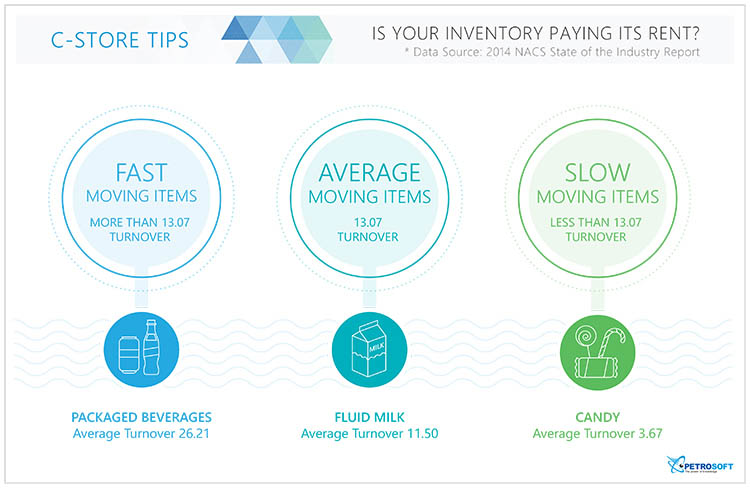How Inventory Movement and Placement Impacts a C-Store’s Bottom Line

Inventory is a core asset that can make or break a convenience (c)-store operation. Managing c-store inventory, which may include thousands of UPCs, requires tracking key data and metrics as well as having the right operational procedures, infrastructure and technology to optimize the inventory. Poor performing inventory can be due to losing inventory through shrinkage, discarding inventory due to spoilage and being overstocked or out-of-stock on inventory items. This can lead to lower sales, profits and margins. A first step in gaining control over a c-store’s bottom line is getting an accurate view of an operations item-level inventory.
Inventory Movement: Industry Averages
What can industry averages tell us about c-store inventory movement? According to the National Association of Convenience Stores (NACS) 2014 State of the Industry Report (SOI), the top performing c-stores had an average inventory turnover of 13.07. High turnover, fast-moving categories for these top performers included packaged beverages (26.21), beer/wine (16.84) and cigarettes (15.76). Convenience store operators can use this category-level data as a benchmark to see how well their own operation is performing in comparison to the industry, but it is the c-store operator’s item-level inventory data that can truly shift their ability to become a top performing c-store operator.

Inventory Movement: The Importance of Item-level Inventory
With the right infrastructure, technology and operational procedures, a c-store’s accurate item-level data can help the c-store manager to ensure that each inventory item on each shelf is paying its rent. Whether in-store inventory items sell quickly with the risk of becoming out-of-stock, at an average rate, or slowly with the risk of becoming overstocked, this data can help the c-store operator make the most of its shelf space and inventory. How can the c-store operator use this data?
If an item is moving slowly, the c-store operator can:
- Rotate/move the slow-moving item to another location in the store
- Move the item to another store if the item sells well at that location
- Clear out dead items with promotions, freeing up space for higher performing inventory
- Return the item to the vendor
A few key enablers to tracking inventory at item-level are physical (cycle) counts and back-office technology systems, such as C-Store Office. In addition, as a cloud-based offering, C-Store Office also provides the infrastructure and forecasting capabilities needed to optimize inventory.
Inventory Placement: Reducing Risk and Increasing Profitability
Managing the placement of inventory items in a store can help resolve inventory movement issues. If retailers aren’t careful, they can lose thousands of dollars through item theft (shrinkage) and expiration (spoilage). In fact, according to the NACS’ 2014 SOI report, the industry’s average shrink rate for 2013 was 1.05% of merchandise sales. Although physical counts can help discover theft, following some best practices and using a back-office system to keep track of inventory can help keep an operation profitable. In addition, by placing some items strategically in the store, it can help boost sales. Some best practices include:
- Keep track of inventory at item-level
- Place high theft (risk) items behind the counter or in the cashier’s line of sight
- Place bestselling (high turnover) items toward the back of the store
- Regularly review inventory item expiration dates
- Regularly review the back-office system’s missing items reports
- Regularly conduct physical (cycle) inventory counts and resolve discrepancies
By having an accurate item-level count and timely inventory reports, the c-store owner can understand how inventory is turning, the risk associated with shrinkage, spoilage and track poor-performing inventory. This provides the c-store owner with the actionable information needed to make the decisions that will affect not only sales but also margins and profits. This actionable information can only exist if the right operational procedures, infrastructure and technology are in place and can be easily accessed by c-store operators. Cloud-based back-office solutions, such as C-Store Office, can provide that infrastructure so c-store owners can make the most of their inventory and shelf space.







2comments